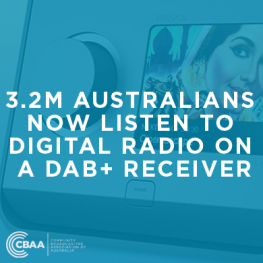
Digital radio take up continues to grow
3.2m people now listen to radio using a DAB+ Digital Radio in Australia, according to the latest research from Gfk, released and compiled by Commercial Radio Australia (CRA), which represents growth to 24.2 percent.
The community broadcasting sector research from the McNair National Listener Survey (CBAA) corroborates the industry-wide research, with latest figures showing that across the five cities where DAB+ radio is currently available (Sydney, Melbourne, Brisbane, Adelaide and Perth) 19% of community radio listening is by way of DAB+ digital radio, with time spent listening averaging 11.5 hours per week. This is a strong result which shows community radio listeners are embracing free to receive DAB+ radio.
53,000 vehicles have been sold in Australia with DAB+ digital radio receivers installed, and the technology is being supported by 21 different vehicle brands ensuring this number will continue to grow.
The CBAA’s Digital Radio Project (DRP) is working to ensure access for community broadcasters now and into the future. Jason Cleary, Station manager of Perth’s RTRFM says,
“A digital radio service is vital to ensure listeners have access to community radio around the country.”
With Australians purchasing DAB+ digital radio receivers at faster than expected rates, access to digital radio for community stations is increasingly important.
For more information on digital community radio contact the CBAA’s Digital Radio Project.
Facebook comments